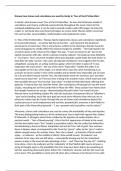Discuss how chance and coincidence are used by Hardy in ‘Tess of the D’Urbervilles’.
In Hardy’s best-known novel ‘Tess of the D’Urbervilles’, he uses the Dickensian model of
coincidence and chance scattered asymmetrically throughout the novel. Given its first
serialised publishing style, it can be said to provide readers with cliff-hangers to draw the
reader in, yet Hardy also uses these techniques to convey other themes which concerned
him such as fate, social mobility, modernisation and employment cycles.
In ‘Tess of the D’Urbervilles’, Thomas Hardy implements chance and coincidence repetitively
to structurally impose – as society did that at the time – and represent the perpetual
permanence of social class. This is a key theme, evident in his choosing a female character
as the protagonist to vividly reflect the minimal margin for mobility – “she had hoped to be
a teacher down at the school in the village” but alas, “T’was not meant to be” due to her
fateful encounter with Alec, which is almost certainly induced - the build-up most definitely
is – by chance. Tess’s recurrent troubles when pursuing jobs usually leads her back home: to
look after her baby ‘Sorrow’, this name already kick-starting her next tragedy when he dies
unbaptised, causing her an aching maternal agony; when her father is taken ill “it was
imperative she must return”, the use of the word “imperative” implies this order is as
inescapable as her fate; when Angel, of a whole other class (his name functioning as an
acronym to mirror society’s view of the wealthy and to denote how impossibly out of reach
he is to any other human) marries Tess, the dairymaids sense her ascension and “put their
hands out to touch her” as if she too were a being from another realm, which may have only
been possible because Tess has that “pure drop” of noble D’Urberville blood, offering that
gateway. If chance does not send her home, then coincidence will plunge her into the worst
of jobs, relocating her to Flint Combe-Ash in Phase the Fifth. These actions from Hardy show
that despite however far you go - demonstrating this point when Tess travels all over
Wessex never truly finding a better life, with the exclusion of temporary bliss at Talbothay’s
- your social standing, much like your past has much more influence than who you are or
what your values may be. Hardy, through the use of chance and coincidence depicts the
cyclical process of rural employment and yet how, paradoxically, everyone is bed-ridden to
their part of the hierarchical pyramid – “I am a peasant only by position, not by nature!”
Moreover, chance and coincidence are used to convey the inevitability of fate and injustice.
The most distinguishing feature is all the misfortunes Tess is dealt with regards Alec Stokes-
D’Urberville. It all begins when Prince is killed by the injection of modernisation into a
pastoral world – “hiss of blood pouring”: this is the first appearance of blood in the novel,
and the descriptive noun “hiss” implies a serpentine malice, like the snake that bribed Eve,
foreshadowing a future of blood, temptation and evil for Tess. Full of guilt, Tess ventures
down a slippery slope accompanied by Alec from the “green” valley to the “grey” roads to
obtain enough money for another horse. Then she is raped – as feminist criticism would
argue – or seduced – as the nobility of Hardy’s time would accuse: ‘Providence’ was
nowhere to be seen, she was left alone – conveniently leaving way for the malevolent
powers at play in the novel to take advantage of her –, and “there lay the pity of’t”. Nothing
to be done, only to be endured, yet the ‘nebulosity’ of that fateful night seems to leave a
string of thought open to the possibility that Tess may have been able to do something to
halt her upcoming downward spiral, before the ‘nebulosity’ cleared, and her fate was truly
set in stone. This possibility is curtly shut off when Alec continues to be thrown in her path;





